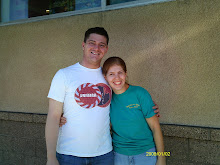
Koreans seem to have quite a knack for mixing things in many varied, and sometimes unthinkable, ways. This afternoon Brandon and I had the privelege of attending a Korean Jazz Orchestra concert. By the end, I wasn't sure if I had witnessed a Korean talk show, the opening of the Jazz Age in 1920, or a 1980's rock concert--as varied as the pieces of music were. And for those of you with a more mellow taste, they had that element, too: a recorder solo and later in the program, authentic traditional music. As we were riding up the elevator back to our apartments afterwards, I had to just shake my head and laugh at the piece-miel selection from the afternoon. I could call it a lot of things, but strictly a jazz concert? Even with jazz's infamous freedom and poetic license, that would be a stretch! The combination of different and, at times, clashing musical genres definitely wasn't soothing for American ears. Perhaps, however, that was one of the concert's strengths: No matter what else it was, it was distinctly Korean and the nationals attending seemed to be proud of that.
The reason I say I felt like I was at a Korean talk show was two-fold: The concert was interrupted multiple times by dialogue and there was nothing in the speaking parts that I understood. A well-dressed young woman walked to the corner of the stage after nearly every selection to explain or comment on the previous song (as far as I gather). At times, she asked the crowd questions in search of a response, to which they would usually reply, "Nay" (which is yes). I assumed she had asked them how well they liked the performance so far. At other times, she walked to the middle of the stage and handed a mic to the performing guest of the moment, presumably for an impromptu interview. Some of the performers addressed the audience for several minutes. I felt like I was in a studio audience! It was just like watching Korean television, I thought to myself--to hear the joke or the act but not to be in on it. I'm not sure if all Korean concerts are conducted this way, but in America, especially during a serious orchestral performance, it would be a cultural faux paux (sp?) to be so verbose!
I felt as if I had jumped decades over to the beginning of the 20th century and the Jazz Age for some musical selections. The orchestra's first piece, a famous arrangement called "In the Mood," featured traditional jazz elements and flapper-like, rather scantily-clad, dancers. At one moment early on, they introduced a woman soloist who sang in English, "It's Only [a] Paper Moon." Singing in English seemed to be appropriate for ushering in the mood of the Jazz Age. I thought she was beautiful and also a little flapper-like, wearing a frilly skirt above her knees and a formless, sparkly sweater top. A few other selections reflected those same early jazz elements, with other singers also singing in English. Even some of the spotlights in the background reminded me of the 20's, with their bold design elements and black-and-white color scheme. During those arrangements, I felt like I was truly listening to real, American jazz.
In the middle of the concert, the star soloist of the evening seemed to steal the show. I remarked to Brandon later that it felt like featuring him was an excuse to give his own concert. He had asked the orchestra to take five and continued to sing without them. The stage lights dimmed and the spotlights changed to a range of phsycodelic, 80's-like colors with matching off-the-wall patterns. The performer broke into what sounded like "Eye of the Tiger," a signature song of the time; it was hard to tell because the melody was familiar but the lyrics themselves were in what I thought was Korean. He also graced us with his rendition of "Hot Stuff," in English this time to aid the foreigners among us. It seems as if his musical talents were well-received, for at one moment in the show, the whole concert hall broke out in singing with him! I was also witness to a woman directly in my view standing up and flailing her arms through one whole song!
As far as the rest... They brought the dancers in and out of the program as it continued, spotlighting them at random times. The show itself ended with what sounded like traditional jazz, featuring another singer and, again, the flapper-dancers. There were seven soloists in all, including the ones just mentioned and a young woman playing two traditional Korean instruments (as far as I could see sitting close to the back of the hall). One was a penny whistle-type woodwind that sounded much too reedy; the other, a small instrument that could have been a cross between a clarinet, a trumpet, and a saxaphone. It was black and silver, shaped with a bell on the end, much like a clarinet but shorter, that was played (at least in this case) half straight out and half down. It sounded very oboe-like and reedy, but also distinctly brassy and like a saxaphone. At one time in the song, it and the alto sax played together. I found that to be interesting because, though the two sounds were similar, musically they sounded distinct.
If I had to do it over again, I probably wouldn't. But I thought it was a very valuable, very unique experience. The Koreans have quite a distinct culture and quite a different definition of the word "performance."

No comments:
Post a Comment